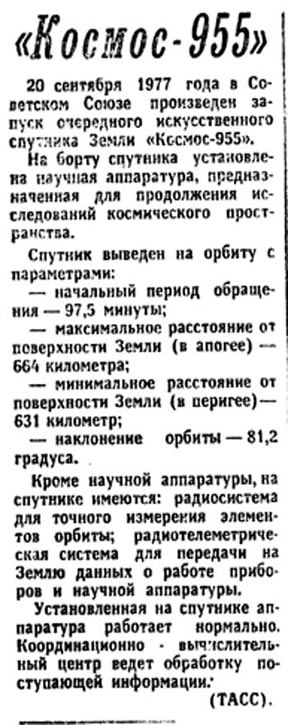Kosmos 955 on:
[Wikipedia]
[Google]
[Amazon]
 Kosmos 955 (;
Kosmos 955 (;
 Kosmos 955 (;
Kosmos 955 (; International Designator
The International Designator, also known as COSPAR ID, is an international identifier assigned to artificial objects in space. It consists of the launch year, a three-digit incrementing launch number of that year and up to a three-letter code repr ...
: 1977-091A, satcat number 10362) was a Soviet ELINT
Signals intelligence (SIGINT) is intelligence-gathering by interception of '' signals'', whether communications between people (communications intelligence—abbreviated to COMINT) or from electronic signals not directly used in communication ...
satellite, launched from the Plesetsk Cosmodrome
Plesetsk Cosmodrome ( rus, Космодром «Плесецк», r=Kosmodrom "Plesetsk", p=kəsmɐˈdrom plʲɪˈsʲet͡sk) is a Russian spaceport located in Mirny, Arkhangelsk Oblast, about 800 km north of Moscow and approximately 200 ...
on September 20, 1977, at 01:01 UTC. The satellite's mass was 2,500 kg. Kosmos 955 had a periapsis
An apsis (; ) is the farthest or nearest point in the orbit of a planetary body about its primary body. For example, the apsides of the Earth are called the aphelion and perihelion.
General description
There are two apsides in any elli ...
of 631 km, apoapsis
An apsis (; ) is the farthest or nearest point in the orbit of a planetary body about its primary body. For example, the apsides of the Earth are called the aphelion and perihelion.
General description
There are two apsides in any elli ...
of 664 km, period inclination of 81.2° and an orbital eccentricity of 0.00235. It was launched by a Vostok-2M
The Vostok-2M (russian: Восток meaning ''"East"''), GRAU index 8A92M was an expendable carrier rocket used by the Soviet Union between 1964 and 1991. Ninety-three were launched, of which one failed. Another was destroyed before launch. It ...
carrier rocket.
It decayed from orbit on 8 September 2000.
Overview
The launch of Kosmos 955 has been suggested as the cause of the Petrozavodsk phenomenon. According to the official report (pictured), the satellite contained scientific equipment for the "further exploration ofouter space
Outer space, commonly shortened to space, is the expanse that exists beyond Earth and its atmosphere and between celestial bodies. Outer space is not completely empty—it is a near-perfect vacuum containing a low density of particles, pred ...
" as well as tools for making exact measurements of its orbital parameters. Also, the satellite was capable of self-observation of its own systems and devices. However, no public data or experiments have ever been returned and it is presumed that it was a test of the military surveillance system, Tselina-D.
References
Kosmos satellites 1977 in the Soviet Union Spacecraft launched in 1977 Reconnaissance satellites of the Soviet Union {{USSR-spacecraft-stub